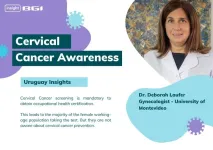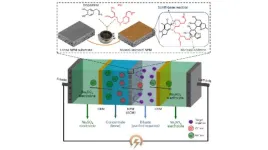(Press-News.org) CAMBRIDGE, MA -- A signaling protein known as STING is a critical player in the human immune system, detecting signs of danger within cells and then activating a variety of defense mechanisms.
STING is primarily on the lookout for DNA, which can indicate either a foreign invader such as a virus or damage to the host tissue or cell. When STING detects that danger signal, it can turn on at least three different pathways — one leading to interferon production, one to non-canonical autophagy (involved in recycling cell components and clearing pathogens), and a third to formation of the inflammasome, a complex of proteins that activates inflammatory responses. The mechanism by which STING stimulates interferon production is well characterized, but it has not been understood how it activates the other two processes.
Now, a team of MIT and Harvard Medical School researchers has discovered how STING activates those two pathways. They found that STING has a surprising and previously unknown function: It can act as an ion channel that allows protons to leak out of an organelle known as the Golgi body. This makes it the first human immune sensor that can translate danger signals into ion flow.
“Arriving at this new idea that STING is a proton channel required connecting prior findings by other labs that either STING or proton flux could activate the inflammasome and non-canonical autophagy, which led us to hypothesize that STING initiates or mediates proton flux to trigger both downstream processes,” says Nir Hacohen, a member of the Broad Institute of MIT and Harvard, a professor of medicine at Massachusetts General Hospital and Harvard Medical School, and a senior author of the study.
“Because of its importance to host immunity, there is a great interest in developing drugs that can activate or suppress STING activity, and the discovery of STING’s ion channel activity will provide new ways to think about designing therapeutics to modulate STING,” says Darrell Irvine, the Underwood-Prescott Professor at MIT with appointments in the departments of Biological Engineering and of Materials Science and Engineering; a member of MIT’s Koch Institute for Integrative Cancer Research and the Ragon Institute of MGH, MIT, and Harvard; and a senior author of the study.
MIT biology PhD student Bingxu Liu and Rebecca Carlson PhD ’23, a recent graduate of the Medical Engineering and Medical Physics program through the Harvard-MIT Division of Health Sciences and Technology, are the lead authors of the paper, which appears today in Science. Paul Blainey, the Karl Van Tassel Associate Professor of Biological Engineering at MIT and a member of the Broad Institute and the Koch Institute, is also an author of the paper.
A surprising role
STING (short for stimulator of interferon genes) is considered one of the major factors that triggers the immune response in the context of infection, autoimmunity, and cancer. Drugs that activate STING have been developed and tested in clinical trials as cancer immunotherapy drugs that would help stimulate the immune system to destroy tumors.
STING is a protein that can span membranes, and it is usually found embedded in the membrane of an organelle called the endoplasmic reticulum (ER). Once it detects DNA, it relocates to the Golgi body, where it begins to activate proteins that turn on genes required for interferon production.
“People know pretty well how STING induces interferon, but how STING induces autophagy and inflammasome formation has been an open debate in the field for the last 10 years,” Liu says.
Previous research has shown that both autophagy and formation of inflammasomes (large protein complexes that stimulate inflammation) can be provoked by protons leaking from cell organelles, which makes the inside of the cell more acidic. Because of that, the researchers wondered if STING might somehow induce proton leakage.
To explore this possibility, the researchers labeled the Golgi with a protein that fluoresces when the pH goes up. When they treated the cells with a molecule that activates STING, the Golgi became less acidic, meaning that it was losing protons. A genetic screen minimized the possibility of another ion channel controlling this ion flow, so the researchers hypothesized that STING itself was acting as a proton channel.
“In addition to its biological significance, this study is a notable example of the maturing functional genomics field, where pooled screening data are sufficiently reliable to set the direction of focused investigation — even from negative results, as was the case here,” Blainey says.
After running the structure of the STING protein through a computer model that can predict whether a given protein structure might contain a pore, the researchers found that the STING protein is predicted to contain a region that resembles a pore. Serendipitously, last year a company that was seeking STING agonists (molecules that activate STING) found a new molecule that was later shown by an academic group to bind in this precise location.
The MIT/Harvard team hypothesized that the agonist, known as C53, blocks the putative pore. When C53 was added to cells , protons did not leak out of the Golgi, and downstream pathways activating autophagy and inflammasome formation were not turned on, even if STING was activated through other means. However, interferon activation, which goes through a different pathway, still occurred.
“For the first time, we were able to decouple these downstream processes, where we can activate interferon with C53, but inhibit those other two pathways leading to autophagy and inflammasome formation,” Carlson says. “In the context of inflammatory diseases where STING is overactivated, we can now start asking which of those molecular mechanisms is most important and contributes the most to the phenotype that we’re seeing.”
Selective control
In future studies, the researchers hope to use C53 to determine the relative importance of these three pathways and try to figure out which ones would be most useful to stimulate or to block to treat a variety of diseases.
The U.S. Food and Drug Administration has not approved any STING agonist thus far, although multiple clinical trials are currently underway. One potential reason that other STING agonists have not made it beyond clinical trials is that the treatment can result in unwanted cell death mediated by STING. Drugs that stimulate interferon production but not cell death or other inflammatory pathways could offer a way to overcome that obstacle, according to the MIT/Harvard team.
The researchers hope to explore whether STING might play a role in influencing the behavior of other cellular activities known to be controlled by ion channels. “Now that we know that STING is an ion channel, we can propose other effects that we think could occur based on this knowledge that STING does transport protons,” Carlson says.
###
The research was funded by the U.S. National Institutes of Health, the Howard Hughes Medical Institute, a Fannie and John Hertz Foundation Fellowship, a U.S. National Science Foundation Graduate Research Fellowship, a European Molecular Biology Organization Fellowship, and a Cancer Research Institute/Bristol Myers Squibb Fellowship.
END
Study finds a surprising new role for a major immune regulator
In addition to turning on genes involved in cell defense, the STING protein also acts as an ion channel, allowing it to control a wide variety of immune responses.
2023-08-03
ELSE PRESS RELEASES FROM THIS DATE:
Winter storms over Labrador Sea influence Gulf Stream system
2023-08-03
The Gulf Stream, which brings warm water from the Gulf of Mexico to Europe and keeps the climate mild, is only part of a larger system of oceanic currents called the Atlantic Meridional Overturning Circulation, or AMOC for short. It runs through the Atlantic like a giant climate machine: as warm water from the tropics is transported northwards at the surface, the current reverses in the North Atlantic – the water cools, becomes heavier and flows south at depth.
Where exactly these sinking processes take place is the subject of current research, and recent measurement programmes have located them to the east of Greenland. ...
Doctors, medical professionals, and artificial intelligence: Innocent bystanders or vicious culprits? – a hot topic of the AI & Medicine 2024 World Congress in Paris, France
2023-08-03
Paris, France – August 3, 2023 – The First International Congress on Artificial Intelligence and Medicine, AI & Medicine 2024, is set to take place on April 11-12, 2024, in Paris, France. Building on the success of IA & Néphrologie 2023, the conference aims to bridge the gap between cutting-edge technology and health care.
AI & Medicine 2024 aims to inform medical professionals about the capabilities of advanced machine learning techniques, and simultaneously raise awareness within the tech industry regarding the unique challenges and requirements of the healthcare sector. The congress will offer a platform to discuss the current applications of AI in diagnostics, ...
A spinout’s biggest competitor may be the parent company, not other entrepreneurs
2023-08-03
Spinouts, or new ventures started by employees leaving a parent firm, often outperform other types of new firms. But a new study published in Strategic Management Journal finds that when parent firms identify and implement ideas internally, they outperform spinouts. For example, if employees at Microsoft leave the parent and start their own spinout in the competing industry, the spinout potentially needs to compete against a new establishment formed by Microsoft in the same industry.
New ventures by former employees often have an edge over competitors because of the knowledge transfer from their ...
FSU researcher finds potential new tool for early identification of dementia risk
2023-08-03
Research at the Florida State University College of Medicine has identified a potential low-cost method for predicting if a person is at risk of developing dementia.
By analyzing data from nearly 13,000 subjects who participated in a long-term aging study, researchers found that an interviewer’s rating of a cognitively healthy person’s memory successfully predicted the likelihood of developing dementia over a 15-year period. Their findings will be published in the Journal of Alzheimer’s Disease.
“Our findings show that interviewers ...
Current takes a surprising path in quantum material
2023-08-03
ITHACA, N.Y. -- Cornell researchers used magnetic imaging to obtain the first direct visualization of how electrons flow in a special type of insulator, and by doing so they discovered that the transport current moves through the interior of the material, rather than at the edges, as scientists had long assumed.
The finding provides new insights into the electron behavior in so-called quantum anomalous Hall insulators and should help settle a decades-long debate about how current flows in more general quantum Hall insulators. These insights will inform the development of topological materials for next-generation quantum devices.
The team’s paper, “Direct ...
Professor Deborah Laufer discusses barriers to cervical cancer screening in Uruguay – BGI Insights
2023-08-03
The recently released BGI Genomics 2023 Global State of Cervical Cancer Awareness Report highlights the level of knowledge, attitudes, and practices related to cervical cancer screening and the human papillomavirus (HPV) on a global scale.
Dr. Deborah Laufer, a gynecologist and Associate Professor at the Faculty of Medicine in the University of Montevideo, offers her insights on this report's findings and the steps needed to improve cervical cancer awareness in Uruguay.
Q: 40% of respondents worldwide did not choose HPV as the key cause of cervical cancer. 37% in Uruguay did not mention it either. ...
Researchers strengthen defenses against common cyberattack
2023-08-03
RICHLAND, Wash.—Scientists have developed a better way to recognize a common internet attack, improving detection by 90 percent compared to current methods.
The new technique developed by computer scientists at the Department of Energy’s Pacific Northwest National Laboratory works by keeping a watchful eye over ever-changing traffic patterns on the internet. The findings were presented on August 2 by PNNL scientist Omer Subasi at the IEEE International Conference on Cyber Security and Resilience, where the manuscript was recognized as the best research paper presented at the meeting.
The ...
Mussel-inspired membrane can boost sustainability and add value to industrial wastewater treatment
2023-08-03
Engineers have developed a new kind of membrane that separates chemicals within wastewater so effectively that they can be reused, presenting a new opportunity for industries to improve sustainability, while extracting valuable by-products and chemicals from wastewater.
Created for use in wastewater treatment, the thin-film composite nanoporous membrane known as a TFC NPM, exhibits an ‘unprecedented’ capability to separate salts and other chemical components from water, and could lead to more sustainable treatment and management of water in a range of industries.
A research ...
CAR-T immune therapy attacks ovarian cancer in mice with a single dose
2023-08-03
CHAMPAIGN, Ill. — CAR-T immune therapies could be effective against solid tumors if the right targets are identified, a new study led by University of Illinois Urbana-Champaign researchers suggests. The researchers successfully deployed CAR-T in a mouse model of ovarian cancer, a type of aggressive, solid-tumor cancer that has eluded such therapies until now.
“Even with an advanced stage tumor model, even with a single dose, we saw strong anti-tumor effects,” said Diana Rose Ranoa, ...
GABA receptors in brain could be targets to treat depression and its cognitive symptoms
2023-08-03
CHAMPAIGN, Ill. — Depression is a complex condition correlated with multiple differences in brain function and mechanisms. A new paper spanning known data about the neurotransmitter GABA and its principal receptors showcases evidence of the receptors’ importance in depression and potential as therapeutic targets.
Based on evidence from research on the receptors’ function in the brain and the drugs that can activate or inhibit them, the authors propose possible mechanisms by which GABA-modulating treatments could ...
LAST 30 PRESS RELEASES:
New fossil study illuminates on the evolutionary success of frogs
Patient-specific human liver model to understand disease mechanisms
Confused by the doctor's questionnaire? U of A study suggests it's common
How do brains stay stable, and when might a dose of flexibility be helpful?
mRNA revitalizes aging immune systems—the liver as a fountain of youth
Rural-urban differences in the prevalence of chronic pain among adult cancer survivors
Food insecurity, burnout, and social isolation among resident and fellow physicians
How do spinal cord injuries heal?
Detailed cell map unlocks secrets of how reproductive organs form
Large language models unleash AI’s potential for autonomous and explainable materials discovery
Gut bacteria have evolved rapidly to digest starches in ultra-processed foods
New risk score helps predict pancreatic cancer recurrence
New evidence challenges understanding of Parkinson’s disease
A new study reveals how embryos and the uterus “talk” during implantation
Cedars-Sinai reports heart attacks, general illness spiked after LA fires
PolyU develops ultra-stable, mucus-inspired hydrogel to boost gastrointestinal wound healing
Flour choice shapes sourdough microbial communities
Can a retinal implant reverse macular degeneration?
Feeding fungi plant remnants produces tasty protein to fortify vegan, vegetarian diets
New tech reduces false positives from breast ultrasounds
Drone-mounted lab monitors fertilizer runoff in real time
Short, light-intensity exercise boosts executive function and elevates mood in children
Jeonbuk National University researchers reveal new interface engineering strategy for efficient and stable back-contact solar cells
Tyrosinase drives hydroquinone-induced exogenous ochronosis: not HGD inhibition
UMass Amherst chemists develop unique tool for studying RNA
Disappointment alters brain chemistry and behavior
A built-in odometer: new study reveals how the brain measures distance
Stress-related brain signals drive risk of cardiovascular disease in people with depression and anxiety
New details on role of fat transport molecules in Alzheimer’s onset
Study illuminates how an antiviral defense mechanism may lead to Alzheimer’s disease
[Press-News.org] Study finds a surprising new role for a major immune regulatorIn addition to turning on genes involved in cell defense, the STING protein also acts as an ion channel, allowing it to control a wide variety of immune responses.




